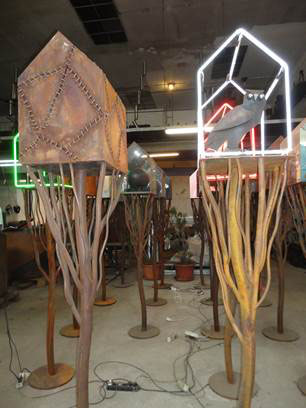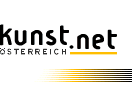
Behruz Heshmat, Iranian artist and metal-worker based in Austria, created tree house sculptures that swayed between his memories and dreams of belonging. Houses are symbols of home and family, of security and, most importantly, of identity. An assembly of tree houses, connected by poetic association, may represent the artist´s longing for the land of his birth, Iran, which, after years and years of separation, grows more distant and uncertain. Objects in the foirm of traditional houses, with sloping roofs and gabkles, were mounted and tree-like stands of steel that branch out at the top to hold them. But the steel branches of Heshmat´s tree houses could also be their mirror image, the roots. These are simplified models of trees and dwellings pared down to their bare essence, eroded by the force of forgetting.
Ideally Heshmat would like to exhibit the entire 35-piece series in groups with the density of a forest.
Each tree, each house, has a different character, reflecting the many aspects of konging, wishful thinking, pain and doubt. Themes, such as the meaning of the home for those in a diaspora or walls as containers of memory and systems of defence, are explored in this melanchiolic encounter; remnants of the past in their present manifestations and the hope of finding acceptance between those who stayed on are all implied in these tree houses. Remote but close, houses searched for had been destroyed as in Burnt House, a completely charred an black house of wood; and Burnt Birth, a black egg inside a house of glass, representing a future with no hope (or possibly a phoenix about to rise from the ashes). Burnt House and Burnt Birth spoke of inhabitants whose potentials had long been lost in random tragedies such as war or life in exile and evoked Farrokhzad´s protaonsits, who suffered in a leper colony. But there were houses of welcome and joy, like the houses of Power, of Reunion, of Hope, of Wisdom and of Light. Zemestan Ast/It´s Winter, a white powder-coated dteel house inscribed with white calligraphy, would be the first home after the exile´s return; it would be cold, feel unlived in, still without the comfort of home The Cactus House and Red House followed - one covered with spikes and defensive expectation of the unknown; the other shielded by the blood of past feuds and distrust, conveyed through red powder-coated steel. The house of a hopeful new beginning and of recovery was Khane, Khane, Khane/House, House, House decorated in many colours with the words House, House, my House. It stands opposite the Black House, a simple dark house of mournful memories, but also of reconciliation.
Emotionally inhabited by Heshmat, these tree houses are homes of metaphors. They contained echoes of loss and the certainly that the return, wanted with deep longing, would be a cruel experience. An exile, alenated and marked by displacment, woukld return to the homeland as a stranger, searching for broken roots. Heshmat has experienced all of these, for such was his own life.
Heshmat waws born in Tabriz, Iran 1953 and has lived and worked in Austria since 1975. An autodidact sculptor, he began working with metal at 1970 and 1975. Heshmat fled his homeland in 1975 and chose Austria as the land of his exile. In 1976 Heshmat became a student at the Academy for Applied Arts in Vienna, eventually becoming an assistant to Professor Wander Bertoni. Heshmat´s oeuvre expresses existential tensions between prevailing ideological and theological prejudices and the socio-political realities of his time. All of these are articulated in spatial terms, in both literal and abstract senses.
In his own words,
My Columns imply rooms and roofs; my Tree House series steal the concept of house (...); my Treasure Chest cubes assume the most elementary forms of architecture. (In my work) there is (always) an inherent onceptual link between form and space, sculpture and architecture.
Autor Lutz Becker, Independent Curator
|




